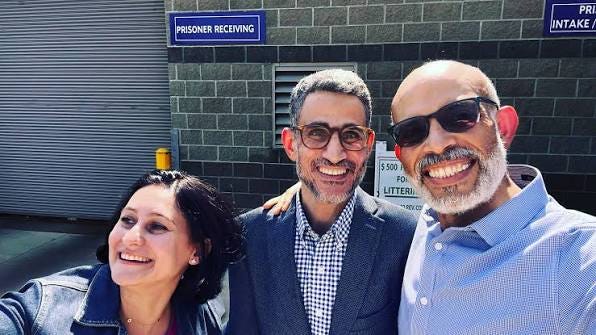Ayman’s freedom was a victory, but it isn’t the finish line. It’s a crack. His case showed how brittle the façade of state power can be when communities apply sustained pressure. Think of it like a windshield on the highway of fascism: one small chip doesn’t seem like much at first, but add the heat of activism, the pressure of public outrage, and suddenly that tiny fracture begins to spiderweb across the glass. What once looked solid reveals itself as fragile. What once seemed unbreakable begins to shatter.
FROM JOURNALIST TO CHAPLAIN TO “TERROR SUSPECT”
Ayman Soliman’s story began in Cairo, where his work as a journalist during the Arab Spring put him on the wrong side of a regime that doesn’t forgive truth-tellers. He fled Egypt in 2014, won asylum in the United States four years later, and rebuilt his life in Cincinnati. He became a hospital chaplain, an imam, a neighbor, the kind of man communities lean on when crisis comes knocking. For a while, his story looked like the kind of immigrant fairytale politicians trot out to prove that America is still the land of refuge.
Then came July 2025. ICE agents yanked him into detention, claiming he had given “material support” to terrorism through an Egyptian charity he once sat on the board of. The allegations were riddled with contradictions. One government notice said he was a “member,” another said he “provided aid,” a third cited research so mangled the original scholars disavowed it. None of it mattered. Ayman was locked in Butler County Jail, his asylum stripped, his freedom hanging by a thread.
BUILDING A FIRE FROM EVERY ANGLE
This is where Cincinnati and Cleveland came alive. Faith leaders, students, immigrant rights advocates, neighbors, even local politicians rallied around a man the government wanted to disappear into paperwork. Clergy signed letters and held prayer circles, staging vigils that framed his detention as a moral outrage rather than a dry legal matter. Lawyers went to work, dismantling the government’s case point by point, exposing sloppy filings and mischaracterizations that made ICE look not just cruel but incompetent.
On the streets, the city itself became a billboard. Sidewalks bloomed with chalked demands for freedom. Caravans of cars and bikes painted with his name rolled through traffic. Choirs gathered in plazas to sing his case into the air. Banners dropped from overpasses like unmissable exclamation points. At every turn, activists found a new way to say his name louder.
WHY THE SYSTEM BLINKED
It would be tempting to say the system worked, but that’s fiction. What worked was pressure. Ayman’s supporters didn’t let the case fade into silence. They humanized him, turned him from “detainee” into chaplain, neighbor, journalist. They layered tactics so that no single action could be dismissed as a blip. They built coalitions broad enough that ICE couldn’t caricature them as fringe. They exposed the weakness of the case until the whole thing looked like a house of cards trembling under the spotlight.
In the end, the cost of deporting him — political, legal, reputational — was higher than the cost of letting him walk free. On September 19, after seventy long days in jail, the government folded. His asylum was reinstated. He stepped back into the daylight not because justice was granted, but because injustice had been made too expensive to sustain.
LESSONS THAT OUTLIVE THE CASE
The fight for Ayman teaches that names matter. Systems thrive on anonymity, on shuffling lives into case numbers. Saying his name, telling his story, putting his face in the public square made him harder to discard. The fight also proved that consistency beats spectacle. A single rally makes headlines for a night; overlapping actions sustain a narrative the press can’t resist. Coalitions matter too — when faith leaders stand next to immigrant youth and local representatives, the state can’t pretend it’s just radicals making noise.
Most of all, the case shows that justice is never handed down like a gift from on high. It’s pried loose. It’s forced. It happens when communities refuse to let silence settle, when every sidewalk, inbox, and public square becomes a weapon against erasure.
THE WORK THAT REMAINS
Ayman’s freedom was a victory, but it’s not the end. Thousands of others remain locked away in ICE detention centers, their names unknown, their stories untold, their cases just as flimsy. The lesson of Ohio is that none of them should be left to vanish quietly. Tell their stories. Build the coalitions. Mix the tactics. Raise the cost of injustice until the system blinks again, and again, and again.
Because the truth is simple: Ayman is free not because America lived up to its promise, but because his community refused to let it break him. The challenge now is to make that same refusal for everyone still waiting in the dark.
At Closer to the Edge, every subscription is a little more heat on the crack in the glass. Help us keep turning up the temperature
This post has been syndicated from Closer to the Edge, where it was published under this address.

